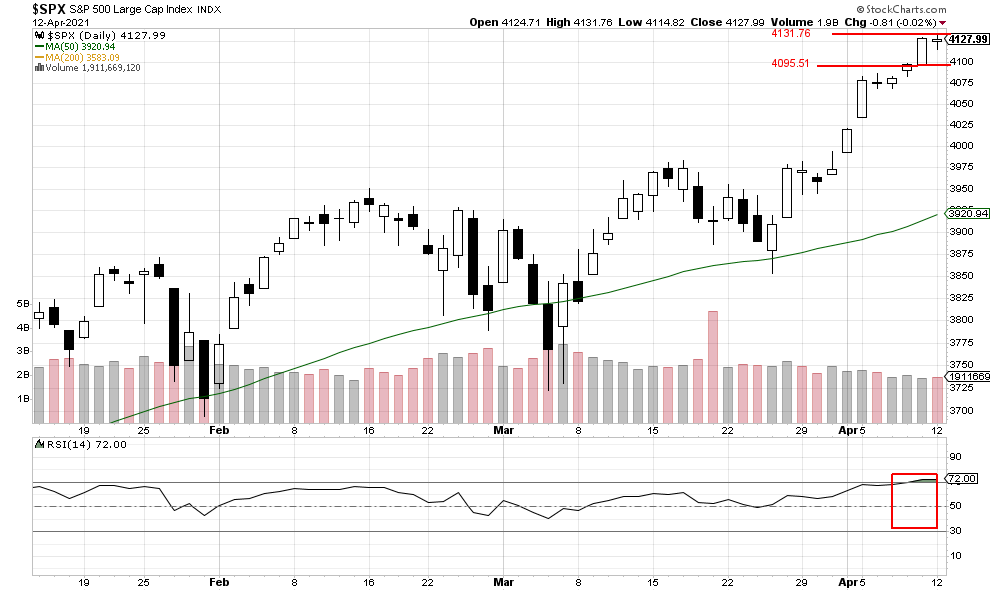Daily Commentary
Headline News:
Stock futures are lower after U.S. federal health agencies recommended pausing the use of Johnson & Johnson’s single-dose COVID-19 shot. Meanwhile, the consumer price index for March rose 0.6% in March and 2.6% from March 2020. Core CPI, excluding food and energy, increased 0.3% and 1.5% year over year. Biden administration economists are now expecting inflation in the coming months, but they also said the increase could be temporary as the economy opens back up later this year.
Markets:
On Monday, the S&P 500 traded sideways, trading in a small range after achieving another all-time intraday high. The index has now formed a short-term trading range of 4095.51 and 4131.76. The volume was again low with only 1,911,669,120 shares traded, and the RSI index remains overbought, closing at 72.00. Recently the bases that have formed have only been 2-3 days long, so we are expecting the same timeframe to apply to this new potential base. The outcome of Q1 earnings and investor’s reaction to the recent inflation numbers could be critical to the next market move.
We are currently long-term bullish and short-term bullish.
John N. Lilly III CPFA
Accredited Portfolio Management Advisor℠
Accredited Asset Management Specialist℠
Portfolio Manager, RJ
Partner, DJWMG
Windsor Wealth Planners & Strategist
Futures trading is speculative, leveraged, and involves substantial risks. Investing always involves risk, including the loss of principal, and futures trading could present additional risk based on underlying commodities investments.
The Relative Strength Index (RSI), developed by J. Welles Wilder, is a momentum oscillator that measures the speed and changes of price movements.
The S&P 500 is an unmanaged index of 500 widely held stocks that is generally considered representative of the U.S stock market. Past performance may not be indicative of future results. Keep in mind that individuals cannot invest directly in any index, and index performance does not include transaction costs or other fees, which will affect actual investment performance. Individual investors’ results will vary. Opinions expressed are those of the author John N. Lilly III, and not necessarily those of Raymond James. “There is no guarantee that these statements, opinions, or forecast provided herein will prove to be correct. “The information contained was received from sources believed to be reliable, but accuracy is not guaranteed. Investing always involves risk, and you may incur a profit or loss. No investment strategy can guarantee success. The charts and/or tables presented herein are for illustrative purposes only and should not be considered as the sole basis for your investment decision. International investing involves special risks, including currency fluctuations, different financial accounting standards, and possible political and economic volatility. Investing in emerging markets can be riskier than investing in well-established foreign markets.
This is not a recommendation to buy or sell any company’s stock mentioned above.
US government bonds and treasury bills are guaranteed by the US government and, if held to maturity, offer a fixed rate of return and guaranteed principal value. US government bonds are issued and guaranteed as to the timely payment of principal and interest by the federal government. Bond prices and yields are subject to change based upon market conditions and availability. If bonds are sold prior to maturity, you may receive more or less than your initial investment. Holding bonds to term allows redemption at par value. There is an inverse relationship between interest rate movements and bond prices. Generally, when interest rates rise, bond prices fall and when interest rates fall, bond prices generally rise.





